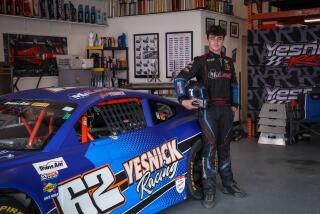Car review: Bugatti Veyron leads entrants in 200-mph supercar club
Life is different driving 200 miles an hour.
The magnitude of what you’re doing — traveling fast enough to lift a loaded Boeing 747 off the ground — is belied by a surprisingly calm environment. It’s quiet, almost, save for some low wind rushing over you and the frantic whir of whatever engine got you there. Outside, the landscape moves past you and the horizon toward you with an ethereal alacrity that’s similar to rushing out of a dream.
FOR THE RECORD:
Supercars: In some copies of the May 31 Business section, a review of three sports cars capable of speeds of 200 mph was accompanied by a photo of the Lamborghini Aventador J concept car, not the production model that was reviewed, the Aventador LP 700-4.
Yet at the risk of stating the obvious, a 200-mph car needs things the tired family sedan does not.
It needs transmissions that shift in milliseconds; brake rotors the size of large pizzas; suspension systems ripped out of Formula One race cars; carbon fiber passenger shells; aerodynamic down force that would hold an elephant to an ice rink; and engines that might have two and sometimes four turbochargers putting out 600, 700 or even 1,000 horsepower.
It is components like these that make up such 200-mph supercars as the McLaren MP4-12C, Lamborghini Aventador and the Bugatti Veyron. McLaren and Lamborghini are the most recent entrants into this exclusive club; while the Bugatti is its undeniable president. Available at graduated, yet always exorbitant price points, these cars are three answers to the same 200-mph question.
Bugatti Veyron Grand Sport
In the automotive world, the grand savant of speed, power and excess is, indisputably, the Bugatti Veyron 16.4.
The car itself is a rolling superlative; nearly any fact or figure about the Veyron is so much an outlier it would make Malcolm Gladwell’s head explode. The Veyron isn’t even new on the market; Bugatti put it on sale in 2006 after years of gestation by German parent company Volkswagen. Yet the data surrounding the Veyron — what it can do and how it’s able to do it — are still staggering.
Let these numbers bounce around your brain helmet for a moment: When it was introduced, the Veyron was the fastest production car in the world with a top speed of 253 mph. (That record was later broken, only to be reclaimed by Bugatti in 2010 with a 1,200-horsepower version of the Veyron called the Super Sport.)
Accelerating from zero to 62 mph takes about 2.5 seconds. Accelerating to 100 mph and back to zero happens in less than nine seconds. Put another way, the Veyron will go from completely motionless to triple digits and back in about the time it takes you to read this sentence.
It’s able to move like this because just behind the passenger compartment, Bugatti dropped an eight-liter, quadruple-turbocharged, 16-cylinder engine that makes 1,001 horsepower and 922 pound-feet of torque.
I tested a 2012 Grand Sport edition with a removable hardtop. Although it’s the length of a Prius, it’s as heavy as a Toyota 4Runner SUV. In an effort to keep that weight as low as possible, the Veyron has a carbon fiber passenger cell onto which an aluminum front structure and a steel rear structure are bolted. This enables the Veyron to be adequately rigid and lightweight, while the rear structure is steel because it’s the best choice for the extreme temperatures the engine and turbochargers produce.
The sticker shock for all this go is just as powerful as the car. The original Veyron 16.4, of which Bugatti sold all 254 copies it made, ran a cool $1.7 million. Each of the 150 Grand Touring models is closer to $2 million, depending on exchange rates with the Euro. Then consider upkeep. Annual service? About $20,000. Tires? $8,700 each for the rear, $6,500 for the front. They last about 6,000 miles.
Yet despite being the most refined, luxurious and powerful machine this side of a Cessna Citation X, to slide into the supple, leather-lined cockpit of the Veyron for a day’s worth of driving reveals an often overlooked fact. It’s still just a car. A noisy car. With the top on or off (it doesn’t stow in the car), the Grand Sport is an aural cacophony of internal combustion.
Other than this noise, and the Veyron’s transcendental acceleration, the rest of the experience is drama-free. The steering is communicative, road grip is excellent, and the ride is firm without being harsh.
But it’s just a car. Prospective buyers shouldn’t expect the hand of God to give you a fist-bump as you drive off.
Lamborghini Aventador
If you’ve ever salsa danced with Chewbacca, then you have a pretty good idea of what it’s like to plow expeditiously through a turn inside Lamborghini’s latest V-12 supercar, the Aventador LP 700-4.
The effect is dizzying. Literally.
Although this $421,145 supercar isn’t a heavyweight at 3,600 pounds, it’s not a welterweight either, and you feel every atom of this mass on the road. When the two of you dance, it leads, and in no other street-legal car have I felt so many G-forces while going around a turn in complete control.
For this, give thanks to the pushrod suspension, a design used almost exclusively in F1 race cars. It keeps the car flatter than a Kid ‘N Play haircut through turns, reduces unsprung weight for more control and allows for a more compliant spring rate. (Somewhat, that is — the Aventador’s ride is still very stiff.)
This vise grip of the road is also aided by an all-wheel-drive system, indicated by the 4 in the LP 700-4. The 700 hints at the metric output of the all-new, naturally aspirated 6.5-liter V-12. For our purposes here in the States, consider the output 691 horsepower, with 509 pound-feet of torque.
The seven-speed transmission is a single-clutch, automated manual unit with paddle shifters. Although it’s lurchy and awkward at low speeds, put it in Track mode and get moving quickly and the shifts happen with a near-violent fervor.
From a dead stop, this car will hit 62 mph in 2.9 seconds on its way to a 217-mph top speed. In its frenzied rush toward double-century speeds, the V-12 behind you sings with the coarse voice of angels. Stopping you yesterday are carbon-ceramic brakes with rotors measuring 15.75 inches in the front and 15 inches in the rear.
It’s this kind of dramatic flourish that the Aventador masters, thus staying true to Lamborghini’s predilection. With a wide and low stance and a design not unlike the love child of a cubist and an origami artist, the Aventador carries itself with civilized brutality like little else on the road.
McLaren MP4-12C
If seeing a supercar dodging through traffic elicits a sharp pang of envy on your part, take solace in knowing that car is likely very difficult to live with on a daily basis.
Unless that car is McLaren’s MP4-12C, in which case the guy cutting you off is likely more comfortable and driving a cooler car than you. Here’s hoping he has a rampant case of halitosis.
The 12C is an all-new, mid-engined, rear-wheel-drive car, billed by British company McLaren as a machine with Jekyll and Hyde properties. Yet in reality, it’s really more like Jackie Chan in a $287,740 suit; smiling and eager everyday, but also capable of doing all its own stunts.
This is evident the moment you sit inside. Outward visibility is excellent thanks to a deep windshield, and you immediately get a sense of where all of the car is. This isn’t an accident.
McLaren designed the 12C so that the driver and passenger sit farther inboard because the closer the driver is to the center of the vehicle, the better sense of control he or she has. This is why the only other street-legal car McLaren produced independently — the legendary F1 from the 1990s — had the driver’s seat literally in the center of the cockpit.
The 12C is powered by a small and light 3.8-liter, twin-turbocharged V-8, producing 592 horsepower and 443 pound-feet of torque. It moves this McLaren from zero to 62 mph in 3.1 seconds on its way to a 205-mph top speed.
Add in an adaptive suspension system, a low curb weight of 3,161 pounds and the excellent driving position and throw it at the road, and the result is a remarkably prescient experience. The 12C goes exactly where you want it, and you always know what the whole car is doing.
The steering talks back wonderfully and aids the sense of precision the driver has. Yet as hard as you push it, the experience never gets raw. For all this McLaren’s capabilities, it seems immune to the base emotions long associated with other supercars. It’s so good at being good, it cauterizes much of the danger right out of your hands. But the experience is so exhilarating, you may be too out of breath to care.
It’s never boring going fast. These cars proved it, even if I didn’t go 200 mph in them.
At the end of the day, because these three approach the art of speed in wildly different ways and price points, it’s unseemly to pick a winner.
Yet those confined to daydreaming can take solace in knowing that since the real experience is so surreal, you’re already halfway there. Buckle up.
david.undercoffler@latimes.com







